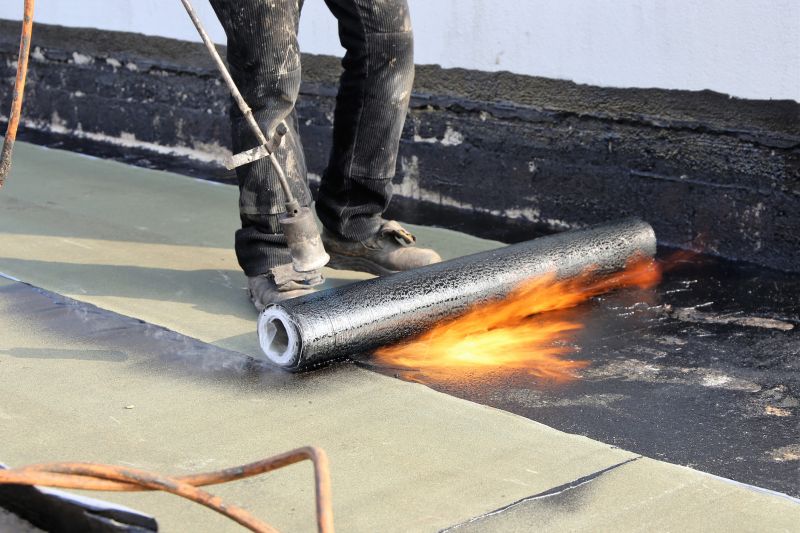Leading Flat Roof Sealings To Protect Your Roof Investment
Identify top sealing solutions that safeguard your flat roof against leaks and extend its functional life.
 Flat roof sealing products are essential components in maintaining the integrity and longevity of flat roofing systems. These products are designed to provide a durable barrier against water infiltration, weather elements, and structural movement. Selecting the appropriate sealing solution depends on various factors such as material compatibility, environmental conditions, and the specific requirements of the roofing surface. Proper sealing not only prevents leaks but also helps in reducing maintenance costs and extending the lifespan of the roof.
Flat roof sealing products are essential components in maintaining the integrity and longevity of flat roofing systems. These products are designed to provide a durable barrier against water infiltration, weather elements, and structural movement. Selecting the appropriate sealing solution depends on various factors such as material compatibility, environmental conditions, and the specific requirements of the roofing surface. Proper sealing not only prevents leaks but also helps in reducing maintenance costs and extending the lifespan of the roof.
Top Overall Option
Flexible Liquid Roof Sealant
A versatile liquid sealant that offers excellent adhesion, flexibility, and weather resistance. It can be applied to various flat roof surfaces and forms a seamless, waterproof membrane upon curing. Ideal for both repairs and new installations, it provides a durable barrier that adapts to roof movement and environmental conditions.
Types of Products For Flat Roof Sealings
Liquid Rubber Coatings
Flexible liquid coatings that create seamless waterproof layers for flat roofs.
Bitumen Membranes
Self-adhesive or torch-applied membranes made from bitumen for durable waterproofing.
EPDM Rubber Sheets
Synthetic rubber sheets that provide reliable waterproofing and UV resistance.
Polyurethane Sealants
High-performance sealants suitable for filling gaps and sealing joints.
Acrylic Coatings
Water-based coatings that reflect sunlight and protect against weathering.
Polyurea Coatings
Rapid-curing coatings offering high flexibility and chemical resistance.
Butyl Rubber Sealants
Highly adhesive sealants ideal for sealing around penetrations and seams.
PVC Membranes
Plasticized PVC sheets that are heat-welded for watertight seals.
Bitumen Asphalt Coatings
Traditional asphalt-based coatings providing a thick waterproof layer.
Silicone Sealants
Flexible, UV-resistant sealants suitable for various roof joints and penetrations.
TPO Membranes
Thermoplastic polyolefin sheets known for durability and ease of installation.
Liquid Flashing
Pourable or brushable sealants used to patch and seal small areas or cracks.
Popular Choices
Widely used for flat roof waterproofing due to their durability and UV resistance.
Commonly selected for their proven waterproofing capabilities and ease of installation.
Popular for their seamless application and versatility across different roof types.
Favored for their durability and heat-welding installation process.
Chosen for their reflective properties and ease of maintenance.
Preferred for their UV resistance and flexibility in sealing roof joints.
Trusted for filling large gaps and providing reliable waterproof seals.
Popular for roof surface protection and reflectivity.
Known for rapid curing and high flexibility, suitable for demanding environments.
Commonly used for sealing around roof penetrations and seams.
Frequently used for small repairs and sealing around penetrations.
Traditional option for thick waterproof layers, still widely used.
Different types of flat roof sealants and membranes are available to suit diverse needs. Liquid sealants can be applied directly to the surface, forming a seamless waterproof layer, while membrane-based options often involve sheets or rolls that are adhered or mechanically fastened. Some products are formulated to withstand extreme temperatures, UV exposure, and chemical resistance, making them suitable for a range of applications.
Installation methods and curing times vary among products, impacting project timelines and labor requirements. It is important to choose products that are compatible with existing roofing materials and that can be applied under the prevailing weather conditions. Proper surface preparation, such as cleaning and priming, is crucial to ensure optimal adhesion and performance of the sealant.
In addition to waterproofing, some sealing products also offer additional benefits like flexibility to accommodate roof movement, UV resistance to prevent degradation, and ease of application for DIY projects. Regular inspection and maintenance with appropriate sealants can help identify potential issues early and maintain the roof’s protective barrier over time.
Key Buying Considerations
- Compatibility with existing roofing materials to ensure proper adhesion.
- Weather resistance features to withstand local climate conditions.
- Application method suitability, including DIY versus professional installation.
- Curing time and how it fits into project timelines.
- Flexibility of the product to accommodate roof movement and thermal expansion.
- UV resistance to prevent degradation over time.
- Chemical resistance if the roof is exposed to pollutants or chemicals.
- Ease of application, including tools required and surface preparation steps.
- Durability and expected lifespan of the sealing product.
- Waterproofing performance and ability to seal seams, joints, and penetrations.
- Cost considerations balanced with product performance.
- Availability of the product in sizes suitable for your project scale.
- Environmental conditions during application to ensure proper curing.
- Warranty or guarantee options offered by the manufacturer.
This page contains affiliate links. We may earn a commission if you purchase through these links, at no additional cost to you.
